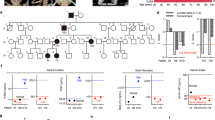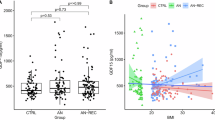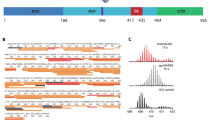Abstract
Gnathodiaphyseal dysplasia (GDD) is an autosomal dominant syndrome characterized by frequent bone fractures at a young age, bowing of tubular bones and cemento-osseus lesions of the jawbones. Anoctamin 5 (ANO5) belongs to the anoctamin protein family that includes calcium-activated chloride channels. However, recent data together with our own experiments reported here add weight to the hypothesis that ANO5 may not function as calcium-activated chloride channel. By sequencing the entire ANO5 gene coding region and untranslated regions in a large Italian GDD family, we found a novel missense mutation causing the p.Thr513Ile substitution. The mutation segregates with the disease in the family and has never been described in any database as a polymorphism. To date, only two mutations on the same cysteine residue at position 356 of ANO5 amino-acid sequence have been described in GDD families. As ANO5 has also been found to be mutated in two different forms of muscular dystrophy, the finding of this third mutation in GDD adds clues to the role of ANO5 in these disorders.
Similar content being viewed by others
Log in or create a free account to read this content
Gain free access to this article, as well as selected content from this journal and more on nature.com
or
References
Ahluwalia J, Ly JQ, Norman E, Costello RF, Beall DP : Gnathodiaphyseal dysplasia. Clin Imaging 2007; 31: 67–69.
Akasaka Y, Nakajima T, Koyama K, Furuya K, Mitsuka Y : Familial cases of new systemic bone disease, hereditary gnatho-diaphyseal sclerosis. Nippon Seikeigeka Gakkai Zasshi 1969; 43: 381–394.
Riminucci M, Collins MT, Corsi A et al: Gnathodiaphyseal dysplasia: a syndrome of fibro-osseous lesions of jawbones, bone fragility, and long bone bowing. J Bone Miner Res 2001; 16: 1710–1718.
Tsutsumi S, Kamata N, Vokes TJ et al: The novel gene encoding a putative transmembrane protein is mutated in gnathodiaphyseal dysplasia (GDD). Am J Hum Genet 2004; 74: 1255–1261.
Katoh M, Katoh M : GDD1 is identical to TMEM16E, a member of the TMEM16 family. Am J Hum Genet 2004; 75: 927–928.
Yang YD, Cho H, Koo JY et al: TMEM16A confers receptor-activated calcium-dependent chloride conductance. Nature 2008; 455: 1210–1215.
Schroeder BC, Cheng T, Jan YN, Jan LY : Expression cloning of TMEM16A as a calcium-activated chloride channel subunit. Cell 2008; 134: 1019–1029.
Caputo A, Caci E, Ferrera L et al2008 TMEM16A, a membrane protein associated with calcium-dependent chloride channel activity. Science 2008; 322: 590–594.
Stohr H, Heisig JB, Benz PM et al: TMEM16B, a novel protein with calcium-dependent chloride channel activity, associates with a presynaptic protein complex in photoreceptor terminals. J Neurosci 2009; 29: 6809–6818.
Stephan AB, Shum EY, Hirsh S, Cygnar KD, Reisert J, Zhao H : ANO2 is the cilial calcium-activated chloride channel that may mediate olfactory amplification. Proc Natl Acad Sci USA 2009; 106: 11776–11781.
Schreiber R, Uliyakina I, Kongsuphol P et al: Expression and function of epithelial anoctamins. J BiolChem 2010; 285: 7838–7845.
Duran C, Qu Z, Osunkoya AO, Cui Y, Hartzell HC : ANOs 3-7 in the Anoctamin/TMEM16 Cl- channel family are intracellular proteins. Am J Physiol 2012; 302: C482–C493.
Milenkovic VM, Brockmann M, Stöhr H, Weber BH, Strauss O : Evolution and functional divergence of the anoctamin family of membrane proteins. BMC Evol Biol 2010; 10: 319.
Martins JR, Faria D, Kongsuphol P, Reisch B, Schreiber R, Kunzelmann K : Anoctamin 6 is an essential component of the outwardly rectifying chloride channel. Proc Natl Acad Sci USA 2011; 108: 18168–18172.
Suzuki J, Umeda M, Sims PJ, Nagata S : Calcium-dependent phospholipid scrambling by TMEM16F. Nature 2010; 468: 834–838.
Tsutsumi S, Inoue H, Sakamoto Y, Mizuta K, Kamata N, Itakura M : Molecular cloning and characterization of the murine gnathodiaphyseal dysplasia gene GDD1. Biochem Biophys Res Commun 2005; 331: 1099–1106.
Mizuta K, Tsutsumi S, Inoue H et al: Molecular characterization of GDD1/TMEM16E, the gene product responsible for autosomal dominant gnathodiaphyseal dysplasia. Biochem Biophys Res Commun 2007; 357: 126–132.
Bolduc V, Marlow G, Boycott KM et al: Recessive mutations in the putative calcium-activated chloride channel anoctamin 5 cause proximal LGMD2L and distal MMD3 muscular dystrophies. Am J Hum Genet 2010; 86: 213–221.
Mahjneh I, Jaiswal J, Lamminen A et al: A new distal myopathy with mutation in anoctamin 5. Neuromuscul Disord 2010; 20: 791–795.
Ferrera L, Caputo A, Ubby I et al: Regulation of TMEM16A chloride channel properties by alternative splicing. J Biol Chem 2009; 284: 33360–33368.
Hicks D, Sarkozy A, Muelas N et al: A founder mutation in anoctamin 5 is a major cause of limb-girdle muscular dystrophy. Brain 2011; 134 ( Pt 1): 171–182.
Deschauer M, Joshi PR, Gläser D, Hanisch F, Stoltenburg G, Zierz S : Muscular dystrophy due to mutations in anoctamin 5: Clinical and molecular genetic findings. Nervenarzt 2011; 82: 1596–1603.
Schessl J, Kress W, Schoser B : Novel ANO5 mutations causing hyper-CK-emia, limb girdle muscular weakness and miyoshi type of muscular dystrophy. Muscle Nerve 2012; 45: 740–742.
Penttilä S, Palmio J, Suominen T et al: Eight new mutations and the expanding phenotype variability in muscular dystrophy caused by ANO5. Neurology 2012; 78: 897–903.
Milone M, Liewluck T, Winder TL, Pianosi PT : Amyloidosis and exercise intolerance in ANO5 muscular dystrophy. Neuromuscul Disord 2011; 22: 13–15.
Sheridan JT, Worthington EN, Yu K, Gabriel SE, Hartzell HC, Tarran R : Characterization of the oligomeric structure of the Ca2+-activated Cl- channel Ano1/TMEM16A. J Biol Biochem 2011; 286: 1381–1388.
Jaiswal JK, Marlow G, Summerill G et al: Patients with a non-dysferlin Miyoshi myopathy have a novel membrane repair defect. Traffic 2007; 8: 77–88.
Vermeer S, Hoischen A, Meijer RPP et al: Targeted next-generation sequencing of a 12.5 Mb homozygous region reveals ANO10 mutations in patients with autosomal-recessive cerebellar ataxia. Am J Hum Genet 2010; 87: 813–819.
Castoldi E, Collins PW, Williamson PL, Bevers EM : Compound heterozygosity for 2 novel TMEM16F mutations in a patient with Scott syndrome. Blood 2011; 117: 4399–4400.
Acknowledgements
We acknowledge the Italian Ministry of Health, Strategic Program, RFPS-4-631972 ‘Genetic Bases of Birth Defects’ for the financial support. We remember Dr Gianni Camera who passed away 7 years ago. He had in charge the family, characterized at clinical level some of the affected members and collected all the samples. We thank him for encouraging this study and for his enthusiastic attitude he always shared with us.
Author information
Authors and Affiliations
Corresponding author
Ethics declarations
Competing interests
The authors declare no conflict of interest.
Rights and permissions
About this article
Cite this article
Marconi, C., Brunamonti Binello, P., Badiali, G. et al. A novel missense mutation in ANO5/TMEM16E is causative for gnathodiaphyseal dyplasia in a large Italian pedigree. Eur J Hum Genet 21, 613–619 (2013). https://doi.org/10.1038/ejhg.2012.224
Received:
Revised:
Accepted:
Published:
Issue date:
DOI: https://doi.org/10.1038/ejhg.2012.224
Keywords
This article is cited by
-
Ano5 modulates calcium signaling during bone homeostasis in gnathodiaphyseal dysplasia
npj Genomic Medicine (2022)
-
The allosteric mechanism leading to an open-groove lipid conductive state of the TMEM16F scramblase
Communications Biology (2022)
-
Identification of a novel ANO5 missense mutation in a Chinese family with familial florid osseous dysplasia
Journal of Human Genetics (2019)
-
Ca2+-activated Cl− channel TMEM16A/ANO1 identified in zebrafish skeletal muscle is crucial for action potential acceleration
Nature Communications (2019)
-
Anoctamin 1/TMEM16A controls intestinal Cl− secretion induced by carbachol and cholera toxin
Experimental & Molecular Medicine (2019)



